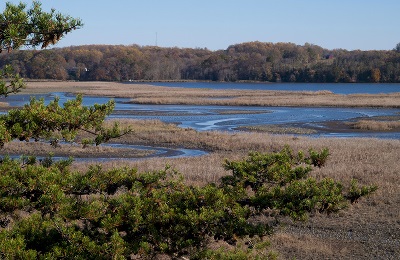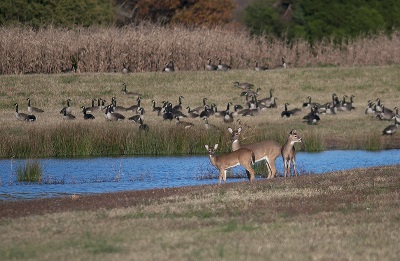 Merkle Wildlife Sanctuary: Nothing says winter like a V-shaped formation of Canada geese winging across a steely sky, their honking carried on a chilly breeze. Cold weather brings tens of thousands of geese, migratory ducks and other waterfowl to the Chesapeake Bay region as the birds seek warmer (or at least less frigid) places to await the return of spring.
Merkle Wildlife Sanctuary: Nothing says winter like a V-shaped formation of Canada geese winging across a steely sky, their honking carried on a chilly breeze. Cold weather brings tens of thousands of geese, migratory ducks and other waterfowl to the Chesapeake Bay region as the birds seek warmer (or at least less frigid) places to await the return of spring.
The Bay is a relatively balmy refuge from the ice and snow that buries all food sources in their Canadian nesting grounds during the coldest months of the year.
There are many places around the Chesapeake region to view wintering waterfowl, and one — the Merkle Wildlife Sanctuary — is just a short drive from populous Baltimore and Washington, DC.
Located on Maryland’s Patuxent River, Merkle is a great spot to see geese on the wing or to catch flocks of them at rest in a field or protected cove. And perhaps best of all, on Sundays, you can do it from the warm comfort of your vehicle.
Merkle is Maryland’s only state-operated wildlife sanctuary. It was named after Edgar Merkle, a wealthy printer and conservation-minded hunter who frequently entertained friends and officials at the 400-acre farm he owned on the Patuxent.
He’s credited with bringing Canada geese to the Western Shore of Maryland. He started by introducing domesticated birds from the Midwest in the 1930s, and then managed his farm as a haven for migratory flocks on their way south for the winter. In 1970, the Merkle family sold the farm to the state.
 Now managed by the Department of Natural Resources, the sanctuary has expanded through the acquisition of neighboring parcels and totals approximately 1,670 acres. It’s home to about 100 resident geese year-round. In winter, though, it hosts several thousand migratory birds, the largest concentration on the Bay’s Western Shore.
Now managed by the Department of Natural Resources, the sanctuary has expanded through the acquisition of neighboring parcels and totals approximately 1,670 acres. It’s home to about 100 resident geese year-round. In winter, though, it hosts several thousand migratory birds, the largest concentration on the Bay’s Western Shore.
On Sundays, visitors can take a short self-guided driving tour and get reasonably close views of waterfowl and other animals.
The Critical Area Driving Tour, as it’s called, is open only on Sunday year-round and, during the winter, only from 10 a.m. to 3 p.m. In warmer months, the route is open Monday through Saturday for hiking, bicycling and horseback riding; Merkle’s grounds are closed for those uses Oct. 1–Jan. 31 to limit the disturbance of the visiting waterfowl.
The driving tour begins at adjoining Patuxent River Park just north of Merkle near U.S. route 301.
It winds through forests and fields, crossing Mattaponi Creek into the wildlife sanctuary. Portions of the 4.3-mile tour are open to two-way traffic, but most of it is a single, unpaved lane.
On my Sunday afternoon visit in December, the traffic was sparse, with only three or four other vehicles spotted during the entire drive.
To get the most out of the tour, it’s best to “walk” your vehicle at speeds of 5 miles per hour or less. At that pace, the drive can take an hour or more, and driver and passengers alike can take in the sights without fear of running off the road. You can also pick up at least some of the sounds of nature if you roll down or even crack a window a bit.
Early on, the drive passes a stubbled cornfield, which during my visit drew flight after flight of honking geese. Though most leaves had browned and fallen, there were still flashes of red and yellow foliage, as well as green patches of hardy ferns carpeting the ground in spots.
There are places to stop and get out along the way. In Patuxent River Park, there’s a boat ramp at the beginning of the tour and a re-created American Indian village, including longhouses similar to those made by ancestors of today’s Piscataway Indians.
Both Patuxent River Park and the Merkle sanctuary are sites on the Captain John Smith Chesapeake National Historic Trail, which highlights the landscapes and Indian communities of the Bay region during the early 1600s, when Smith made his explorations.
Signs dot the driving route, with snippets of information about the natural and human history of the region. Bluebird boxes sit on posts just off the road.
Crossing Mattaponi Creek calls for traversing a 1,000-foot, bending wooden bridge. Near the middle of the span, you’ll find a short observation tower with room for a couple of cars to stop near its base.
Farther on, in a wooded stretch, there’s more space to stop and take a short hike to a steel observation tower. After climbing several flights of stairs to the top, you’ll reach a platform with a panoramic view above the treetops of water and wetlands. Birders often set up their scopes here to sweep the sky and landscape for new and old winged friends.
A few trails branch off from the driving route near the water, a couple of them leading to fishing spots The sanctuary has five ponds stocked with largemouth bass, bluegill and other species, though fishing is off-limits until April 1.
The driving route eventually peels away from the waterfront, crossing open fields and meadows. In one large field surrounded on three sides by woods, a herd of about 20 deer browsed on the green shoots of a recently planted winter cover crop. They raised their heads as our vehicle appeared, then went back to grazing, perhaps aware that in this sanctuary, humans pose no threat.
The tour ends at Merkle’s entrance drive, leading either out of the sanctuary or to its visitor center, which until May 1 is open on weekends from 10 a.m. to 4 p.m. A sign on the building proclaims: “This place is for the birds.” From indoors or out, visitors can use binoculars and scopes provided there to scan the surrounding fields and distant water for wildlife.
Inside, interpretive displays showcase the life history and management of the Canada goose, as well as local American Indian heritage, early European settlement and the Patuxent’s role in the War of 1812. There’s a spot for children’s crafts, and several live animals are on display, including an Eastern screech owl, snakes, a diamondback terrapin and other turtles.
For those who want to stretch their legs, there are four hiking trails that explore the upland forests and marshes bordering the Patuxent. The walks range from easy to moderate, from nearly three-fourths of a mile to 3 miles in length. One, Lookout Creek Trail, can only be accessed from the driving tour, while the others start out near the visitor’s center.
“It’s just a great way to learn, from a different source and right at the source,” said Avis Turner, who lives not far from Merkle and brought her 9-year-old son Jack to a ranger-led hike through the woods one Sunday afternoon this fall.
The sanctuary is free and open year-round from sunrise to sunset. Leashed pets are permitted. Check the DNR web site for a schedule of guided hikes, craft workshops and lectures on such diverse topics as beekeeping, tree identification and stargazing.
Timothy B. Wheeler is managing editor and project writer for the Bay Journal. He has more than two decades of experience covering the environment for The Baltimore Sun and other media outlets. Send Tim an e-mail.
